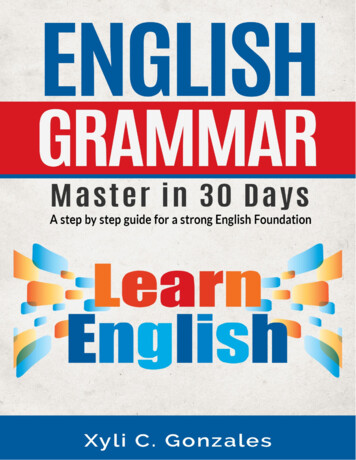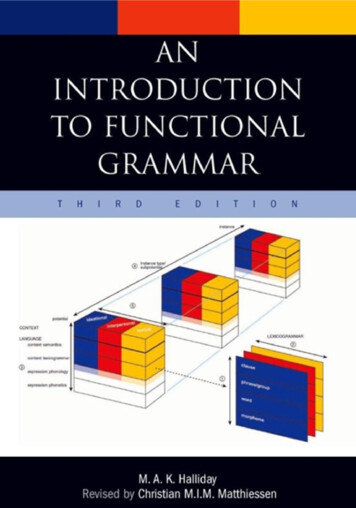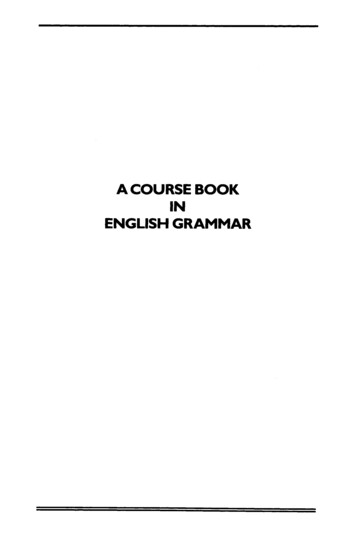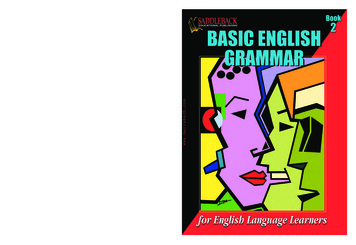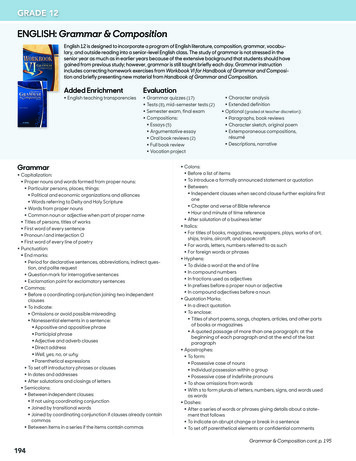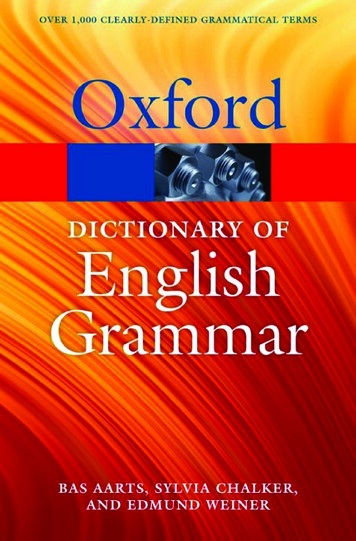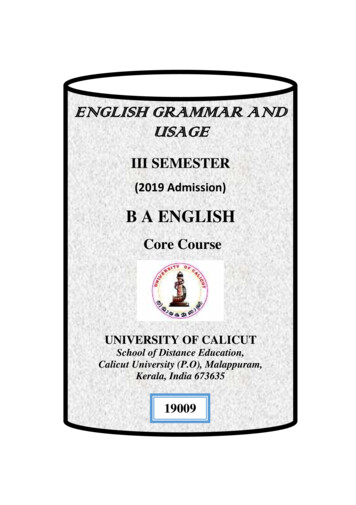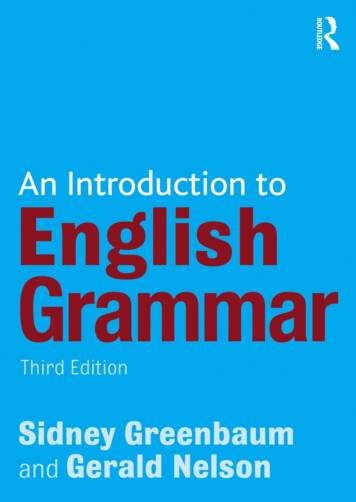
Transcription
An Introduction toEnglish Grammar
This page intentionally left blank
An Introduction toEnglish GrammarThird EditionSidney GreenbaumGerald Nelson
First published 1999 by Pearson Education LimitedThird Edition published in Great Britain in 2009Published 2013 by Routledge2 Park Square, Milton Park, Abingdon, Oxon OX14 4RN711 Third Avenue, New York, NY 10017, USARoutledge is an imprint of the Taylor & Francis Group, an informa business Gerald Nelson, Sholem Greenbaum, Ariel Greenbaum and Eti Kornbluth1999, 2009The right of Sidney Greenbaum to be identified as Author of this Work hasbeen asserted by him in accordance with the Copyright, Designs andPatents Act 1988.All rights reserved. No part of this book may be reprinted or reproduced or utilised in any form orby any electronic, mechanical, or other means, now known or hereafter invented, includingphotocopying and recording, or in any information storage or retrieval system, without permissionin writing from the publishers.NoticesKnowledge and best practice in this field are constantly changing. As new research and experiencebroaden our understanding, changes in research methods, professional practices, or medicaltreatment may become necessary.Practitioners and researchers must always rely on their own experience and knowledge inevaluating and using any information, methods, compounds, or experiments described herein. Inusing such information or methods they should be mindful of their own safety and the safety ofothers, including parties for whom they have a professional responsibility.To the fullest extent of the law, neither the Publisher nor the authors, contributors, or editors,assume any liability for any injury and/or damage to persons or property as a matter of productsliability, negligence or otherwise, or from any use or operation of any methods, products,instructions, or ideas contained in the material herein.ISBN 13: 978-1-4058-7412-0 (pbk)British Library Cataloguing in Publication DataA CIP catalogue record for this book can be obtained from the British LibraryLibrary of Congress Cataloging in Publication DataA CIP catalog record for this book can be obtained from the Library of CongressTypeset in 10.5/13pt Minion by 35
ContentsPreface to the Third 0.60.70.80.9What is grammar?Grammar and other aspects of languageGrammars of EnglishNational varieties of EnglishStandard English and non-standard EnglishVariation according to useDescriptive rules and prescriptive rulesWhy study grammar?How this book is organisedxiixiii1112234456PART I: THE GRAMMAR71. The parts of the simple sentence91.1 Structure, form, function1.2 Subject, predicate, verb1.3 Operator1.4 Do, Be, and Have1.5 Subject and verb1.6 Subject1.7 Transitive verbs and direct object1.8 Linking verbs and subject complement1.9 Intransitive verbs and adverbials1.10 Adverbial complement1.11 Direct object and indirect object1.12 Direct object and object complement1.13 The basic sentence structures1.14 The meanings of the sentence elementsExercisesAdvanced exercises9101011121415161617181920222529v
CONTENTS2. Word 262.272.282.292.302.312.322.332.34viOpen and closed classesWord classes and word usesNounsNoun suffixesNoun classesNumberGenderCaseDependent and independent genitivesMain verbsVerb suffixesRegular verbsIrregular verbsAuxiliariesClasses of auxiliariesThe passive auxiliaryThe progressive auxiliaryThe perfect auxiliaryAuxiliary doModal auxiliariesThe meanings of the modalsAdjectivesAdjective suffixesAdjective classesGradability and comparisonAdverbsAdverb suffixesGradability and comparisonPronounsPronoun classesPersonal pronounsPossessive pronounsReflexive pronounsDemonstrative pronounsReciprocal pronounsInterrogative pronounsRelative pronounsIndefinite pronouns and numeralsPronoun oneDeterminersClasses of 040414141424344444445454647474849494950515252
CONTENTS2.352.362.372.38Central determinersThe articles and ns2.39 Coordinating conjunctions2.40 Subordinating conjunctionsPrepositions2.41 Simple prepositions2.42 Complex prepositionsExercisesAdvanced exercises3. The structures of 3.143.153.163.173.183.193.203.213.223.233.24Phrase typesThe noun phraseThe structure of the noun phraseDeterminersModifiersRelative clausesAppositive clausesAppositionCoordination of noun phrasesNoun phrase complexityFunctions of noun phrasesThe verb phraseThe structure of the verb phraseMain verbsTense, person and numberAspectVoiceExpressing future timeThe ordering of auxiliariesFinite and non-finite verb phrasesMoodMulti-word verbsThe adjective phraseThe structure of the adjective phraseFunctions of adjective phrasesThe adverb phraseThe structure of the adverb phraseFunctions of adverb 970717272727374757777798081848485868687vii
CONTENTSThe prepositional phrase3.25 The structure of the prepositional phrase3.26 Functions of prepositional phrasesExercisesAdvanced exercises4.Sentences and clauses4.1 What is a sentence?4.2 Irregular sentences and non-sentences4.3 What is a clause?4.4 Sentence types4.5 Declaratives4.6 Interrogatives4.7 Imperatives4.8 Exclamatives4.9 Speech acts4.10 Active and passive sentences4.11 Positive and negative sentences4.12 Compound sentences4.13 Complex sentences and subordinate clauses4.14 Non-finite and verbless clauses4.15 Functions of subordinate clauses4.16 Sentence complexity4.17 There-structures4.18 Cleft sentences4.19 Anticipatory itExercisesAdvanced 08109110110111112113115115115116121PART II: THE APPLICATIONS1235. Usage erb agreementThe general rulesAndOr, norWithCollective nounsIndefinite pronounsQuantity phrasesSingular nouns ending in -s125125126127128128129130130
CONTENTS5.95.105.115.12Who, which, thatWhatThere is, there areCitations and titlesCase5.13 Subject complement5.14 Coordinated phrases5.15 After as and than5.16 After but5.17 After let5.18 Who, whom5.19 Case with -ing clausesAuxiliaries and verbs5.20 Problems with auxiliaries5.21 Lie, lay5.22 Present tense5.23 Past and -ed participle5.24 Past and were subjunctive5.25 Multiple negationAdjectives and adverbs5.26 Confusion between adjectives and adverbs5.27 Comparison5.28 Only5.29 Dangling modifiersExercisesAdvanced 51361361361371381381381391401401411476. 156Style in writingEmphasis6.2 End-focus6.3 Front-focus6.4 There-structures and cleft sentences6.5 Parenthetic expressionsClarity6.6 End-weight6.7 Misplaced expressions6.8 Abstract nouns6.9 Modifiers in noun phrases6.10 Subordination6.11 Parallelism6.12 Repeated soundsix
CONTENTS6.13 Pronoun referenceConsistency6.14 Pronoun agreement6.15 Tense consistencyExercisesAdvanced exercises7. English in use7.17.27.37.47.57.67.7Register variationConversational EnglishUnscripted monologueSports commentaryEnglish in emails and text messagesEnglish in chatrooms and message boardsThe language of literature7.7.1 Foregrounding7.7.2 AmbiguityExercisesAdvanced exercises8. Punctuation8.1 Punctuation rules8.2 Sentence fragments and fragmentary sentences8.3 Run-on sentences and comma splices8.4 Coordinated main clauses8.5 Direct speech8.6 Citations8.7 Questions8.8 Restrictive and non-restrictive relative clauses8.9 Restrictive and non-restrictive apposition8.10 Adverbial clauses8.11 Vocatives and interjections8.12 Avoiding misunderstanding8.13 Genitives of nouns8.14 Genitives of pronounsExercisesAdvanced exercises9. Spelling9.19.29.3xSpelling, pronunciation and meaningSpelling variantsSpelling rules for short and long vowel 19220220225227227228229
CONTENTS9.4 Suffixes9.5 Prefixes9.6 Other aids to spelling9.7 Homophones: words pronounced similarlyExercisesAdvanced exercisesGlossaryFurther readingIndex230236236238243245247271273xi
Preface to the Third EditionSidney Greenbaum’s An Introduction to English Grammar was first published in 1991,and a second edition, which I edited, appeared in 2002.In preparing this third edition, I have rearranged the material to some extent, togive what I hope is a clearer order of presentation. Part I, The Grammar, now beginswith an overview of the elements of sentence structure in terms of their forms andgrammatical functions. The Grammar then moves from the smallest units of analysis(words and word classes) through progressively larger and more complex units:phrases, clauses and sentences.I have introduced Usage Notes at various points throughout the text, to highlightareas of usage which may be disputed and which often cause difficulties for writers.I have extended the chapter entitled English in Use (Chapter 7) to include a newsection on the language used in internet chatrooms and message boards. As in thesecond edition, the exercises appear at the end of each chapter. I have increased thenumber of exercises, and have separated the advanced exercises from the rest. Citationshave been updated, where necessary, and the Further Reading section has been completely revised.Many of the citations and extracts used in this book have been taken from theBritish component of the International Corpus of English (ICE-GB). ICE-GB is a onemillion-word collection of samples of contemporary British English, taken from bothspoken and written sources. The corpus is available from the Survey of English Usage,University College London (http://www.ucl.ac.uk/english-usage/).Many of the exercises were compiled by Professor Charles F. Meyer (University ofMassachusetts-Boston). I am grateful to Ren Hongtao for his careful reading of themanuscript. Any remaining errors are my own.GERALD NELSONDepartment of EnglishThe Chinese University of Hong Kong2008xii
AcknowledgementsThe publishers are grateful to David Higham Associates Limited for permission toreproduce an extract from ‘This Bread I Break’ by Dylan Thomas from Collected Poemspublished by J.M. Dent.xiii
To Sholem and WendyJonathan, David and Simawith affection
Introductionn 0.1What is grammar?We will be using the word grammar in this book to refer to the set of rules that allowus to combine words in English into larger units. Another term for grammar in thissense is syntax.Some combinations of words are possible in English, while others are not possible.Every native speaker of English can easily judge that Home computers are now muchcheaper is a possible English sentence, whereas Home computers now much are cheaperis not, because they know that much is wrongly positioned in the second example. Theability to recognise such distinctions is evidence that in some sense native speakersalready know the rules of grammar, even if they have never formally studied grammar.Similarly, native speakers apply the rules every time they speak or write (they can putwords in the right order) and every time they interpret what others say (they know thatSusan likes Tom means something quite different from Tom likes Susan).We acquire a working knowledge of our native language simply through beingexposed to it from early childhood: nobody taught us, for example, where to positionmuch. However, we undertake a formal study of grammar in order to make explicit theknowledge of the rules which we apply when we use the language. There is a clear difference between having a working knowledge of our native language and having a formal knowledge of the rules of its grammar. After all, many languages have never beenanalysed in terms of their grammar, and some have been analysed only fairly recently.People were speaking and writing English long before the first English grammars werewritten towards the end of the sixteenth century.n 0.2Grammar and other aspects of languageLinguistic communications are channelled mainly through our senses of sound andsight. Grammar is the central component of language. It mediates between the systemof sounds or of written symbols, on the one hand, and the system of meaning, on theother. Phonology is the usual term for the sound system in the language: the distinctive sound units and the ways which they may be combined. Orthography parallelsphonology in that it deals with the writing system in the language: the distinctive written symbols and their possible combinations. Semantics is concerned with the systemof meanings in the language: the meanings of words and the combinatory meanings oflarger units.Three other aspects of language description are often distinguished: phonetics,morphology and pragmatics. Phonetics deals with the physical characteristics of the1
AN INTRODUCTION TO ENGLISH GRAMMARsounds in the language and how the sounds are produced. Sounds and letters combineto form words or parts of words. Morphology refers to the set of rules that describe thestructure of words. The word computer, for example, consists of two parts: the basecompute (used separately as a verb) and the suffix -er (also found in many other nounsderived from verbs, e.g. printer, blender, cooker). Pragmatics is concerned with the use ofparticular utterances within particular contexts. For example, Will you join our group?is a question that, depending on the speaker’s intention, is either a request for information or a request for action.For descriptive purposes, it is convenient to deal with the components of languageseparately, but because of the central place of grammar in the language system, it issometimes necessary to refer to the other components when we discuss the grammar.n 0.3Grammars of EnglishThere are many grammars of English, that is to say books describing English grammar.They differ in how much of the grammar they cover and in how they set out the rules.There are also some differences in the categorisation and terminology they use. Nevertheless, most categories and terms are widely shared, deriving from a long tradition ofgrammatical description.The grammatical analysis in this book follows the approach found in AComprehensive Grammar of the English Language by Randolph Quirk, SidneyGreenbaum, Geoffrey Leech, and Jan Svartvik. First published in 1985, that is areference work on contemporary English grammar that contains nearly 1800 pages.A shorter version, A Student’s Grammar of the English Language, by Sidney Greenbaumand Randolph Quirk, is also available. For details of these and other useful references,see the Further Reading section at the end of this book.n 0.4National varieties of EnglishEnglish is the first language of over 350 million people. Most of them live in the UnitedStates of America, which has about 250 million native speakers of English, and theUnited Kingdom, with about 58 million. Other countries with large numbers of Englishnative speakers that also constitute the majority of the population are Canada (about17 million), Australia (about 16 million), the Irish Republic (about 3.9 million), andNew Zealand (about 3.9 million). Some countries have large concentrations of Englishnative speakers, though they do not constitute the majority of the population; forexample, South Africa has about 3.5 million native English speakers, though they2
INTRODUCTIONconstitute only about 8 per cent of the total population. While recognising that thesepeople all speak English, we can distinguish the national varieties they use as AmericanEnglish, British English, Canadian English, and so on.English is a second language for over 300 million people who speak another language as their native tongue but also use English in communicating with their compatriots. For example, the first language for about 24 per cent of Canadians is French andfor about 10 per cent of Americans it is Spanish. English is also the second language incountries where only a small minority speak it as their mother tongue but where it isthe official language or joint official language for government business. Among thesecountries is India, where it is estimated that about 30 million people speak Englishas their second language (though these constitute only about 3 per cent of India’spopulation of one billion). Other countries where English is the official or joint officiallanguage include Gambia, Ghana, Nigeria, the Philippines, Puerto Rico, Tanzania,Uganda, Zambia and Zimbabwe. Since the English in each of these countries hascertain distinctive features, it is reasonable to refer to such national varieties as, forexample, Indian English or Nigerian English.Finally, English is studied in classrooms around the world as the primary foreignlanguage. Its popularity lies in its value as an international language. A knowledge ofEnglish is perceived in most parts of the world as essential for international communication in business and tourism, in internet communication and in scientific andtechnological literature.n 0.5Standard English and non-standard EnglishAs well as differences between national varieties of English, there are also differenceswithin each national variety. Each has a number of dialects. In countries where themajority speak English as their first language, one dialect is used nationally for officialpurposes. That dialect is called Standard English.Standard English is the national dialect that generally appears in print. It is taughtin schools, and students are expected to use it in their essays. It is the norm for dictionaries and grammars. We expect to find it in official printed communications, such asletters from government officials, solicitors and accountants. We expect to hear it innational news broadcasts and documentary programmes on radio or television, andwe expect to read it on official websites.Within each national variety, the standard dialect is relatively homogeneous ingrammar, vocabulary, spelling and punctuation. Pronunciation is a different matter,since there is no equivalent standard accent (type of pronunciation). For each nationalvariety there are regional accents, related to a geographical area, and social accents,related to the educational, socio-economic, and ethnic backgrounds of the speakers. InBritish English, Received Pronunciation (RP) is a non-regional social accent associatedwith public school education but it is not regarded as a standard accent to be learnedin schools throughout the country. It is spoken by about 3 per cent of the populationin Britain.3
AN INTRODUCTION TO ENGLISH GRAMMARStandard English has prestige because people associate it with education and withhigher-income social groups. It is not intrinsically better than other dialects, thoughmany believe it is. One of its major advantages is that it has developed a range of stylesto suit different kinds of uses of the language, particularly in writing.Non-standard dialects tend to be restricted to people from a particular region orfrom a particular social group or to social groups within a region. Many people speakmore than one dialect, and can switch effortlessly between them, perhaps using different dialects at home and at work.n 0.6Variation according to useLanguage also varies according to context and communicative purpose. For example,newspapers, cookery books, scientific papers, emails, poetry and fiction all have distinctive language features. Newspapers have a distinctive layout, headlines are oftenhighly compressed (Banks warned on student loans), cookery books tend to use manyimperatives (Mix the ingredients), scientific papers use many passive constructions(A colourless gas is produced ). These varieties are known as registers, that is, varietiesof language associated with specific uses and communicative purposes.Some variation depends on the medium, that is, the channel of communication.There is a major distinction between spoken and written language. Conversation, themost common type of speech, involves immediate interchange between the participants, who convey their reactions both in words and through facial expressions andphysical gestures. There is more spontaneity in conversation than in writing; selfcorrection occurs in the flow of conversation, whereas it is eliminated through editingin writing. Writing needs to be more explicit, since obscurities and misunderstandingscannot be resolved immediately. People feel more committed to what they writebecause of the potential permanence of the written communication. The differences inthe nature of the media are reflected in the greater concision that is possible in writingand in the greater care that writers take over their choice of words.Language also varies according to the attitude of the speaker or writer towards thelistener or reader, towards the topic and towards the purpose of communication. Wecan select from features that range from the most formal to the most informal. Forinstance, comprehend and strive are more formal than their respective equivalents,understand and try. Similarly, This is the student to whom I gave the message is more formal than This is the student I gave the message to.In Chapter 7 we examine the grammatical features of a range of registers, includingconversations, sports commentaries, emails, text messages and literary texts.n 0.7Descriptive rules and prescriptive rulesAt the beginning of this Introduction, we said that the rules of grammar state whichcombinations of words are possible in the language and which are not. Our exampleof an impossible sentence in English was Home computers now much are cheaper. The4
INTRODUCTIONrule that disallows that sentence is a descriptive rule, that is, a rule that describes howpeople use their language. The validity of this descriptive rule depends on whether itis true that Home computers are now much cheaper is a possible English sentence andHome computers now much are cheaper is an impossible English sentence. The evidenceto validate this rule is drawn from the knowledge that speakers of English have of theirlanguage as well as from samples of their actual use of the language. Of course thedescriptive rule must be accurately formulated to make the valid distinctions.Sometimes people speaking the same dialect disagree in their evaluation of particular sentences. For example, some speakers of standard British English find acceptableI demand that she gives her reasons; others prefer or require a different form of the verbin the that- clause, either that she give her reasons or that she should give her reasons.A number of differences in the use of standard British English have acquired socialimportance. Some speakers of the standard dialect consider that certain usages marktheir user as uneducated. Rules that specify which usages should be adopted or avoidedare called prescriptive rules. Examples of prescriptive rules are:nnnnDon’t use like as a conjunction, as in He speaks like his father does.Don’t use between you and I, but between you and me.Don’t split an infinitive, as in to actually feel.Don’t use them people, but those peopleSpeakers of the standard dialect tend to pay greater attention to prescriptive rules whenthey are on their best behaviour, in particular when they are writing in a formal style.n 0.8Why study grammar?The study of language is a part of general knowledge. We study the complex workingof the human body to understand ourselves; the same reason should attract us tostudying the marvellous complexity of human language.Everybody has attitudes towards the English language and its varieties, and hasopinions on specific features. These attitudes and opinions affect relationships withother people. If you understand the nature of language, you will realise the grounds foryour linguistic prejudices and perhaps moderate them; you will also more clearly assesslinguistic issues of public concern, such as worries about the state of the language orwhat to do about the teaching of immigrants. Studying the English language has a moreimmediate practical application: it can help you to use the language more effectively.In the study of language, grammar occupies a central position. But there is also apractical reason to emphasise the study of grammar. It is easy to learn to use dictionaries by yourself to find the pronunciation, spelling, or meanings of words, but it isdifficult to consult grammar books without a considerable knowledge of grammar.There are several applications of grammatical study: (a) A recognition of grammatical structures is often essential for punctuation; (b) A study of one’s native grammaris helpful when one studies the grammar of a foreign language; (c) A knowledge ofgrammar is a help in the interpretation of literary as well as non-literary texts, since the5
AN INTRODUCTION TO ENGLISH GRAMMARinterpretation of a passage sometimes depends crucially on grammatical analysis;(d) A study of the grammatical resources of English is useful in composition: in particular, it can help you to evaluate the choices available to you when you come to revisean earlier written draft.n 0.9How this book is organisedThis book consists of two main parts. Part I is The Grammar (Chapters 1–4), whichbegins with an overview of the major sentence elements, and then goes on to discuss progressively larger units: words, phrases, clauses and sentences. Part II is TheApplications (Chapters 5–9). In this part we discuss common usage problems andwriting styles, as well as variation in English grammar according to register (Chapter 7).Part II concludes with chapters on punctuation (Chapter 8) and spelling (Chapter 9).The book concludes with a Glossary of grammatical terms, and with some suggestionsfor further reading.A set of exercises follows each chapter, with advanced exercises at the end. Answersto all the exercises, as well as additional exercises, are available on the companionwebsite www.routledge.com/ 9781405874120.6
Part IThe Grammar
This page intentionally left blank
1n 1.1The Parts of the SimpleSentenceStructure, form, functionIConsider this sentence:There are various ways of analysing this. One way is to say that the sentence containsthree units:A heavy snowfallhas blockedthe mountain passesWe cannot simply arrange the units in any way that we like. For example, [1a] belowis not an English sentence:[1a] Has blocked the mountain passes a heavy snowfall.Sentence [1] has a structure in that there are rules that decide the units that can cooccur in the sentence and the order in which they can occur.The three units in [1] are phrases. Phrases also have a structure. We cannot rearrange the internal order of the three phrases in [1]. These are not English phrases:heavy snowfall a, blocked has, the passes mountain.A heavy snowfall and the mountain passes are noun phrases (3.2) and has blocked isa verb phrase (3.11). We characterise them as these types of phrases because of theirstructure: in the noun phrases the main word is a noun, while in the verb phrase themain word is a verb. When we describe items in this way in terms of their structure,we are referring to grammatical form.We can also look at the three units in terms of their grammatical function, or howthey are used in a particular sentence. For example, in [1] A heavy snowfall is thesubject of the sentence and the mountain passes is the direct object of the sentence (1.5–7):[1] A heavy snowfall has blocked the mountain passes.However, in [2] below, a heavy snowfall is the direct object and in [3] the mountainpasses is the subject:9The Grammar[1] A heavy snowfall has blocked the mountain passes.
AN INTRODUCTION TO ENGLISH GRAMMAR[2] They encountered a heavy snowfall.[3] The mountain passes are now open.We therefore see that identical forms may have different functions in different sentences.We can now combine the descriptions by form and by function. Turning back to [1],we can say that A heavy snowfall is a noun phrase (form) used as a subject (function),and the mountain passes is a noun phrase (form) used as a direct object (function). Inthis chapter we will be examining the function of the phrases, not their form. In the nextsection, we will take a preliminary look at the functions of the parts of a simple sentence.n 1.2Subject, predicate, verbWe can divide a sentence into two main constituents: the subject and the predicate.The predicate consists of the verb and any other elements of the sentence apart fromthe subject:subjectIThe chefThe earthquakepredicatelearned all this much later.is a young man with broad experience of the world.measured 6.8 on the Richter Scale.The most important constituent of the predicate is the verb. Indeed, it is the mostimportant constituent in the sentence, since regular sentences may consist of only averb: imperatives such as Help! and Look! The verb of the sentence may consist of morethan one word: could have been imagining. The main verb in this verb phrase comeslast: imagining. The verbs that come before the main verb are auxiliary verbs (‘helpingverbs’), or simply auxiliaries: could have been.Notice that, following traditional practice, we use the word verb in two distinct senses:1. Like the subject, the verb is a constituent in sentence structure. In [1] the verb of thesentence is stroked and in [2] it is has been working:[1] Anthony stroked his beard.[2] Ellen has been working all day.2. ‘Verb’ is also one of the word classes (Chapter 2), just like ‘noun’, ‘adjective’, ‘preposition’, and so on. In this sense, [2] contains three verbs: the auxiliaries has andbeen and the main verb working. The three verbs in [2] form a unit, which is calleda verb phrase (3.11).n 1.3OperatorIn section 1.2 we divided the sentence into two parts: the subject and the predicate.We then pointed to the verb as the most important constitu
0.1 What is grammar? 1 0.2 Grammar and other aspects of language 1 0.3 Grammars of English 2 0.4 National varieties of English 2 0.5 Standard English and non-standard English 3 0.6 Variation according to use 4 0.7 Descriptive rules and prescriptive rules 4 0.8 Why study grammar? 5 0.9 How this book is organised 6 PART I: THE GRAMMAR 7 1.

